As an Amazon Associate I earn from qualifying purchases.
Brining olives is the oldest way to cure olives, especially green ones. What follows are instructions and troubleshooting on how to cure olives with a brine. There are other ways I’ll get to below.
This post assumes you have access to fresh, green olives off the tree, which are pretty but inedible — they are impossibly astringent. Olive trees can be found all over California, in many parts of Arizona, as well as Australia and, obviously, the Mediterranean, where they are native.
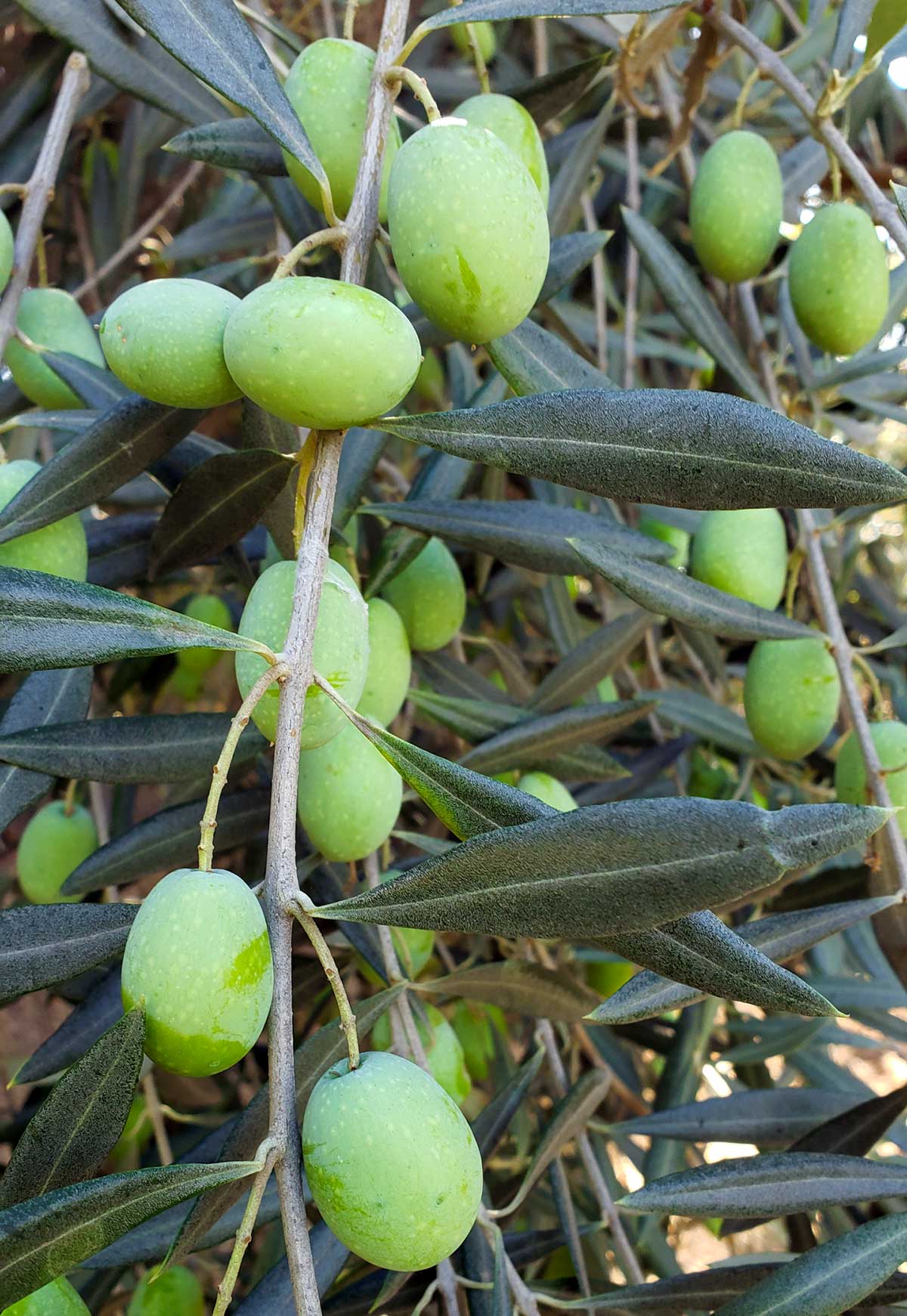
You can buy fresh olives online, and over the years I have provided links, but these companies seem to come and go quickly, so I don’t do that anymore. Just Google “buy fresh olives” around September here in the United States, and I think March in Australia.
The timing is important because you want fresh green olives. And yes, like peppers, all olives start green and ripen to another color, usually black in the case of olives.
Green, unripe olives are firmer and way more astringent than ripe ones. Brining olives when they are green is a great way to cure them, and green olives are the only olives suitable for what, admittedly, is my favorite cure, which a lye cured olive. That process, believe it or not, has been used for 2000 years, and is not as scary as it sounds.
You can brine ripe, black olives, too, just so you know.
My general rhythm is to cruise my local parks in late September or early October; they are full of olive trees, remnants of pre-suburbia orchards around here. On some crisp autumn Saturday, I go picking. Look for pretty olives, with few or no blemishes, and which are not wrinkled.
Tiny dots on an olive are OK, but many may be rotten with olive fly, whose larvae burrow into olives and leave a beige scar where they entered. that telltale scar means there is a visitor lurking within your olive.
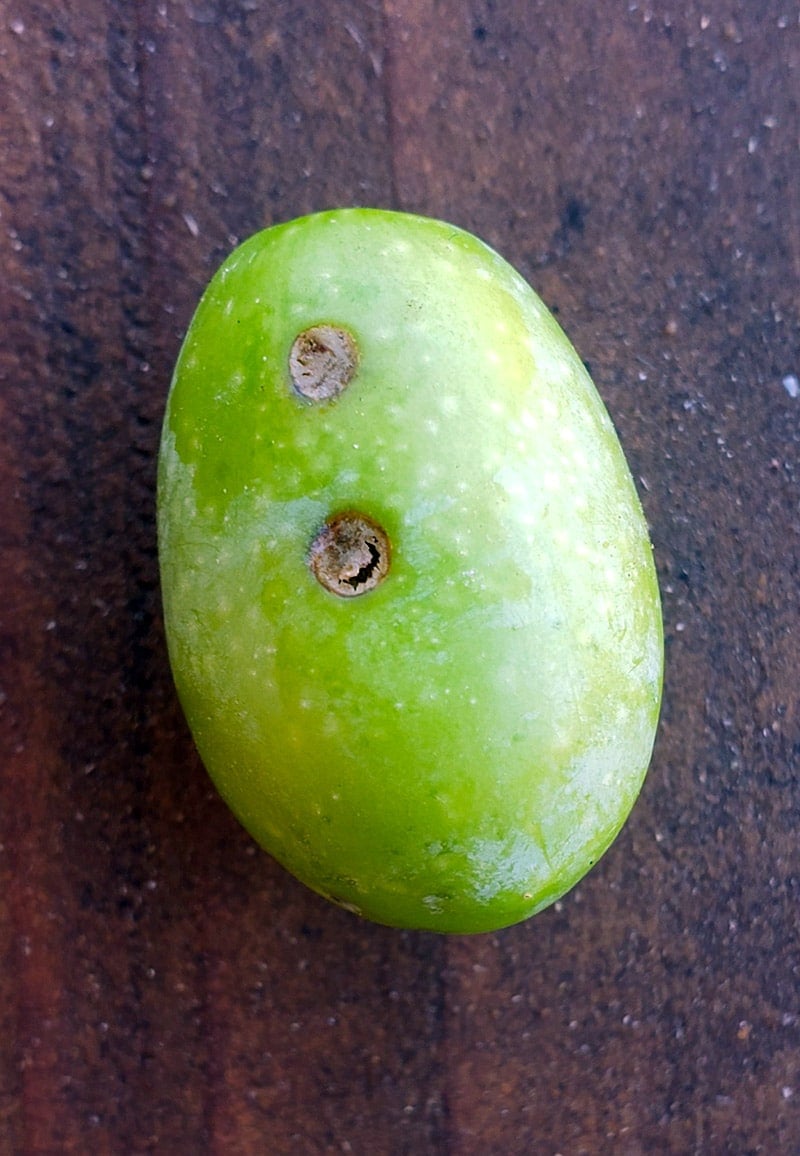
Another hazard are the dry olives. Trees forced to live by their own wits — away from regularly watered grass — are stressed, and their olives shrivel early. Shriveled olives are usable, but they bruise rapidly and don’t make a clean green olive.
When you get home, separate your olives into small, medium and large olives — it doesn’t matter what variety they are, as I don’t know how to tell the difference. If you don’t have enough large ones to make its own batch, mix them with the mediums.
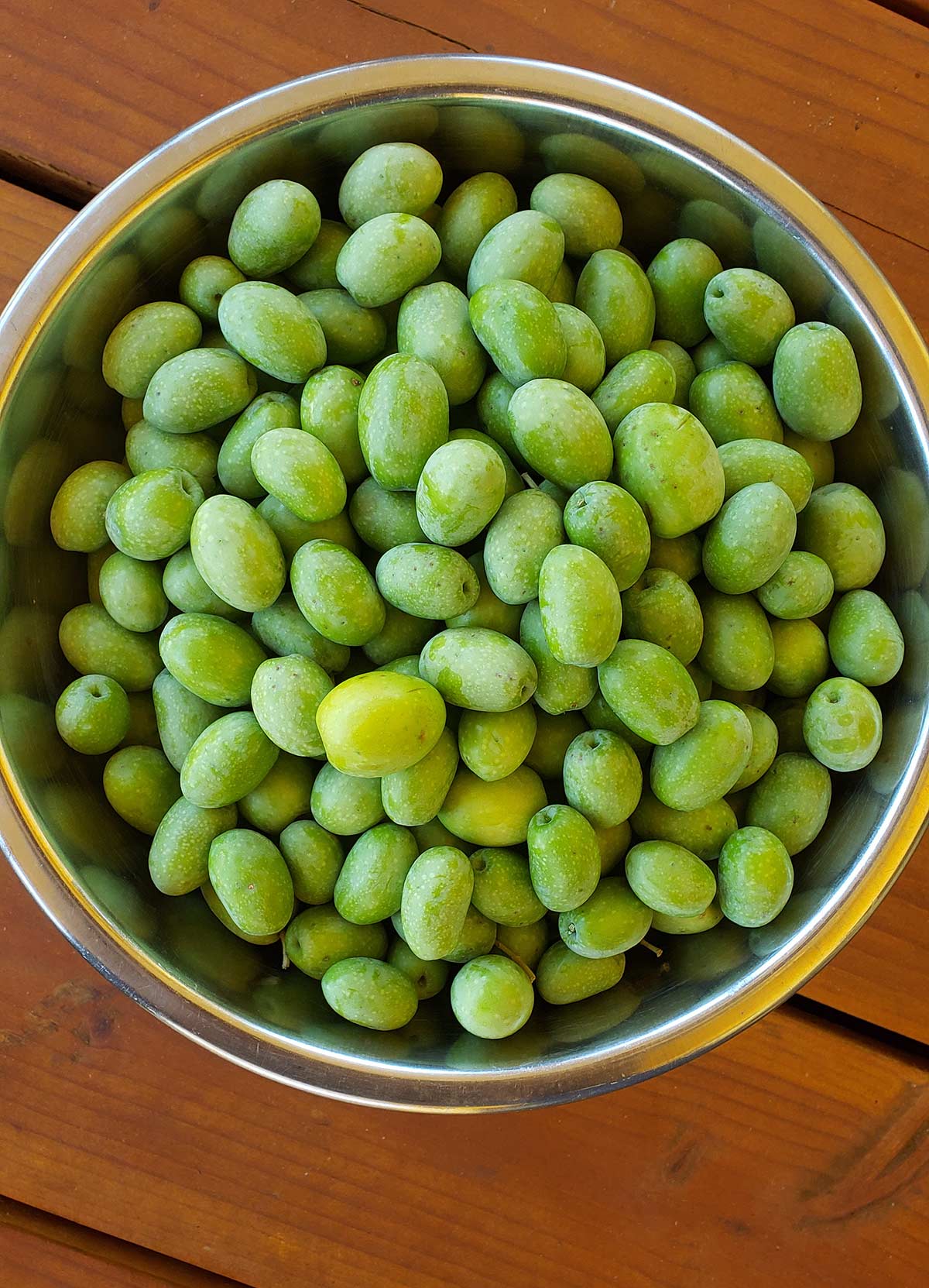
Unless I am doing the lye cure, brining olives is my preferred method, as it is low-maintenance and results in a super-tangy, salty olive that keeps for more than a year and cries out for beer or ouzo. And I like ouzo. A lot.
Brine-curing is easy, but takes a long time. You make a brine of 1/4 cup kosher salt (I use Diamond Crystal) to 4 cups water, plus 1/2 cup of vinegar: white wine, cider or simple white vinegar. Submerge the olives in this brine and top with cheesecloth or something else to keep them underwater. Do not cut them.
Cover the top of the container loosely (I use large, 1 gallon glass jars) and put the jar in a dark, cool place. That’s it. Check it from time to time — meaning every week or so at first. The brine should darken, and you might get a scum on the top. That’s OK.
What’s going on is that your olives are fermenting; it is the fermentation that breaks down the oleuropein over time. The what? Yeah, oleuropein is the astringent substance in an unripe olive. It needs to go if you are going to eat one. Fermentation is why I never wash my olives before curing — I want those natural yeasts on the outside of the olive to do their magic.
I change my brine every month or two, when it begins to look extra nasty. I don’t re-rinse the olives, during changes, either, because I want the residue to act as a “starter” to get the next batch of brine going.
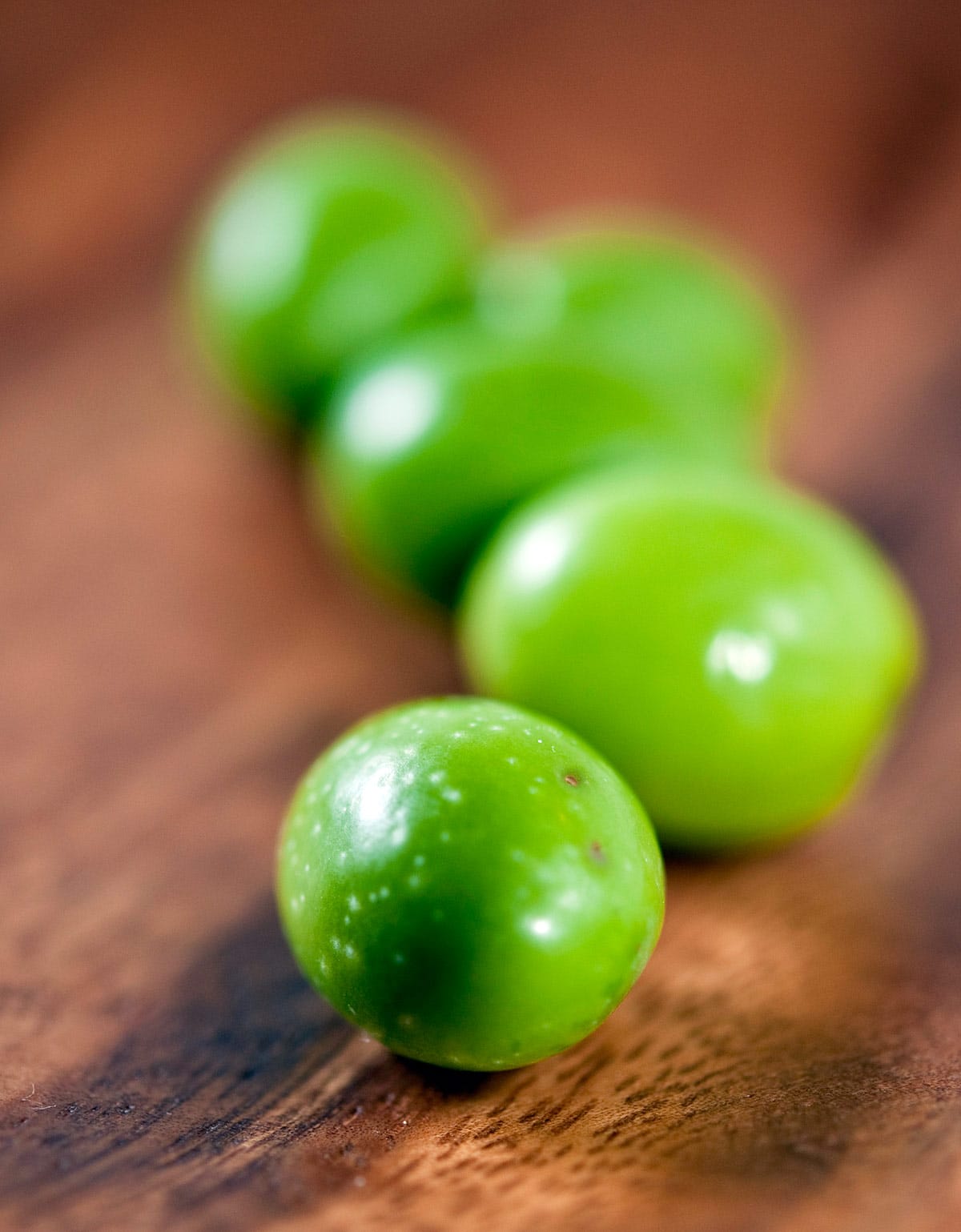
Keep in mind you will be in for the long haul: Olives picked in October are typically ready to eat in May or June. It’s a lot like making wine.
Add seasonings after the New Year, or even later, otherwise you risk too much spice and not enough olive flavor; this is especially true of chiles. If you find you’ve gone too far, change the brine and don’t add new seasonings, and let it steep for a few weeks. That should calm things down a bit.
Once the olives are finished, there is a certain show-off factor when you pull out a plate of olives you cured yourself. “These are your olives? Wow.” Plus, you can flavor them any way you like, which is a bonus.
If you’re too late for green olives, I really like salt cured black olives, which we all call oil-cured olives since that’s how they are stored. If you want to cure black olives, my method is to oil-cure olives.
Brine Cured Green Olives
Ingredients
- 4 pounds fresh green olives
- 1 cup kosher salt
- 1 gallon water
- 1 cup distilled vinegar
Instructions
- Assuming you've already checked your olives for worm scars (see headnotes), discard any with too many blemishes. Place the olives in a stoneware crock or large glass jar with a lid carefully. Fresh olives actually do bruise easily.
- Mix the vinegar, salt and water together. No need to boil, as it will dissolve at room temperature. Pour this over the olives, making sure they are submerged by at least 2 inches. Add more brine in the same ratio if need be.
- Chances are the olives will float. You need to keep them away from air, so I put a plate over them that is just about the size of the jar or crock. You can also use a plastic bag filled with water to keep the olives away from air. Once the olives are submerged, cover the jar or lid (lightly screw on the top if there is one) and place the container in a cool, dark place. A basement is ideal. You don't want them to ever get beyond 75°F if you can help it, because at higher temperatures the olives can go soft. Since this is a wintertime cure, it should not be a problem. Low temperatures are fine, just don't let them freeze. Let them sit for several months.
- As time passes, you will see a scum of mold and weirdness form on the top. This is normal. Skim it off once a week and you'll be fine. At some point the brine itself will get pretty icky. I like to change the brine every month or so, but this is not strictly needed. The olives are done when they are no longer bitter, anywhere from 2 to 4 months.
- Only now do you add other seasonings, like chile peppers, black peppercorns, herbs or citrus peel. Do this in a fresh brine, and let this new, flavorful brine sit 2 weeks before serving. Store the olives in this brine, in a cool place or refrigerator, for up to 2 years. I keep them in quart Mason jars.
Notes
Flavor Additions
- dried chiles
- bay leaves or similar aromatic leaves like citrus leaves
- thyme, sage, oregano, rosemary
- allspice, black peppercorns, juniper berries
- smashed garlic cloves
Nutrition
Nutrition information is automatically calculated, so should only be used as an approximation.

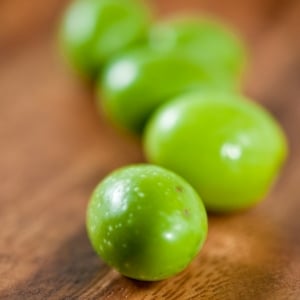




Thanks for the article.
Do you need to keep it in refrigeration during the brining process? My Chicago studio space ranges in temps betweek 60-75 in the winter so wondering if I have to keep it in the fridge…a month seems manageable for the first part but as it takes up so much room, wondering if we can ferment at room temp?
I brined my Barouni olives with salt brine in November last year and opened a jar in April and they were bitter and I let the rest continue to brine. I opened a jar just now in September and they are still bitter. Is there anything I can do? Can I drain the jars and rinse and perhaps re-brine with a saltier mix? or are they a total loss and I have to start over with fresh raw olives again? Not sure what contributed to the bitterness.
Patti: They’ll be fine. Happens to me, too.
I just started a batch of green olives and I sliced them and have been soaking them for about a week. The spots where I sliced them are turning brown and they also have brown spots on them. What is that from and should I continue to soak them or are they no good. The last time I did olives I used the dark ones and they were fantastic. Thank for your help.
Thanks for the instructions on brining. Do I really have to wait until Spring to enjoy them? A few years ago I salt-cured them for about a month; a very earthy layer of flavor around a lot of pit. Olive fruit flies have been a big problem. I have tried Torula yeast tablet lures, and had 36% of my harvest infested. Any suggestions for organic methods.that might improve the yield? I suppose I could just yield to Mother Nature…
Cory: Go Badgers!!! Don’t pit them. Pit after brining. 😉
hank it appears you’re the az-ca-wi connection. I went to Marquette and live in az now. always good to hear of a fellow cheeselander escaping the cold.you didn’t really answer the “should I pit them before brining or after question”. I gotta know since it’s pickin’ time here. thanx
You can buy raw olives from Chaffin Family Farms in Oroville, CA. They are a family farm with beautiful old olive groves, and I believe they ship to anywhere in the continental US.
Thanks Hank. I’ll let you know how it goes.
Neil: I’d leave them in the brine until you want to eat some in the next few weeks. When you are ready to eat some, move to the smaller containers.
Hi there, i’m about to cure my first olives and was wondering about storing them once brined. do you recommend separating them into smaller containers and covering with oil or leaving them in the brine?
Go Badgers! I retired to Arizona and want to make olives like my Italian friends do back in WI. I just ordered 10 pounds of olives from Temecula, CA and they will arrive in a few weeks so I want to make sure I process them right away. The way I was taught was to crack open the olives and remove the pit, then soak them for around 3 weeks, changing the water daily. Then drain them and place them in quart canning jars with clean water and several teaspoons of kosher salt. Several weeks later they were ready to eat. We drained them and then sprinkled them with 1t. garlic powder, 1t. oregano, 1/4t. red pepper flakes, and enough salad oil to coat them. This gave them a nice Italian taste. Should I continue to remove the pits or leave them in? Do the pits affect the flavor? Can the olives be shrink wrapped after brining and stored out of the refrigerator? Thanks!!
Cathy: yes, it is possible. Our season around Sacramento is not until October, so while it seems a little early, I’d give it a go.
I also live in AZ and our tree`s olives are just now (Mid August)turning from green to dark purple. Am I too late or is it time?
Thanks Hank! I am so excited to see what they will turn out like in comparison to the batches I have tried in the past
Kristin: Yep, they brown a bit. Ultimately they will be, um, olive drab. 😉
Hi! I have cured green olives using lye in previous years and wanted to try the water curing method. I live in AZ desert area so olives ripen a little earlier than for you I think. I picked my green olives yesterday morning ~3 gallons worth and spent a couple hours slicing the olive with my paring knife and immediately dropping them into a “coolish” water bath. When I went to change my water today, I see that the olives are all turning brown around the incision. Any guidance for me on this? All olives have stayed fully submerged in water since they were pierced yesterday. When I used the lye curing method all olives stayed a beautiful green so I am a little concerned that I may have some contamination or something. If the browning is normal, that is OK, I was just not really prepared for that and was curious if you have the same results with the area around your piercings. Thanks! Great instructions for this process!
Greg: My olives always sink, so that’s no biggie.
I have a batch of green brine cured olives that have taken about 6 weeks so far, two weeks longer than the black batch. From experience green ones take longer so that’s ok, but these also have all sunk to the bottom of the jar. All my other batches have floated. Is there any explanation you can come up with. They don’t seem off, but I am curious/cautious.
(Up until yesterday about a third we’re floating but I pricked the whole batch with a table fork and now they have all sunk)
My brine-cured black olives are nearly ready after 4 weeks in brine, changed once at two weeks.